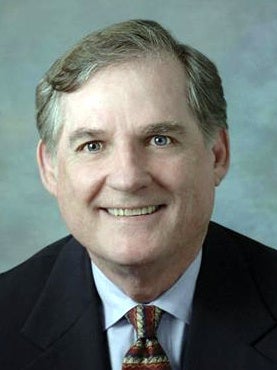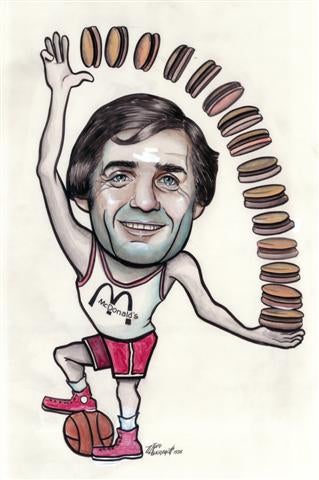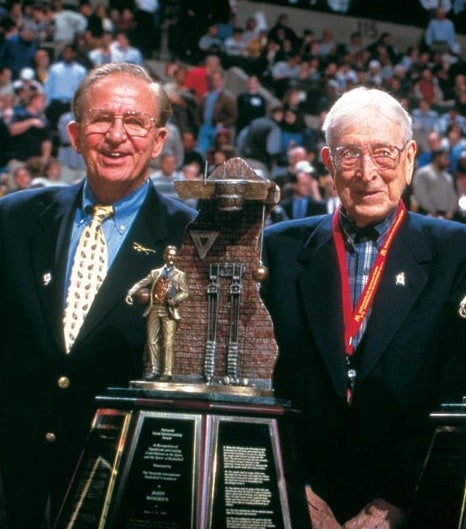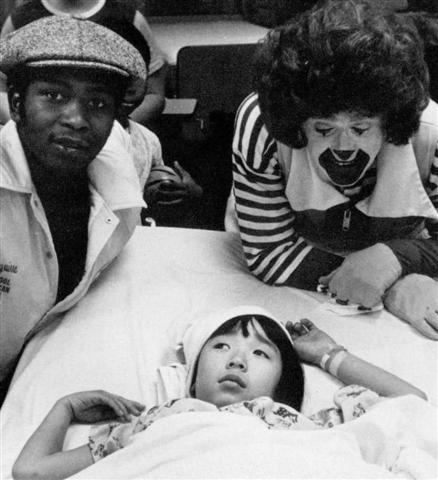Even though founder and executive director Bob Geoghan believed that the McDonald’s All-American High School Basketball Game would "only last four or five years," he will be directing the 33rd annual contest March 31 at Value City Arena in Columbus (Ohio). The girls showcase will be held for the ninth time.
The game, which rotates across the country and matches the premier seniors in an East-versus-West format, was initiated in 1978 and quickly became the Gold Standard for high school all-star contests.

Bob Geoghan.
Photo courtesy of McDonald's
Bruce Weber, who spent 44 years at
Scholastic Coach Magazine, said, "McDonald’s came in and changed the way things were done."
He was referring to the fact that "paper" All-American teams, such as the one his publication selected for many years, were one-upped from then on because now the best players in the country had a national stage on which to perform.
Though there were a few other all-star games already in existence, they always pitted a state or metro area against a national team. McDonald’s was the first to divide the country evenly, therefore, getting the best possible talent each year. In later years the game reached national television and has been there ever since.
Geoghan, who lived in Maryland, had founded the Quarterback Club of Washington (D.C.) in 1964 and was its director for 30 years. Working as an insurance salesman, he first delved into the world of basketball promotions by pitting the Virginia prep all-stars against the best from Maryland in a 1971 game, which drew 1,500 to Blair High School in Montgomery (Md.).
Three years later, he began dreaming about putting an all-star game into the new Washington Bullets’ Capital Centre, which seated over 19,000 in Landover (Md.). Looking for a sponsor, he noted, "A lot of high school kids worked for McDonald’s. That would be perfect. At the time, I figured I’d just buy a ticket and watch. But they (representatives from Washington, D.C., Baltimore and the Eastern Shore) said I’d have to run it. We did it on a handshake."

Geoghan did it all in those days.
Drawing courtesy of McDonald's.
Geoghan offered a deal that couldn’t be refused: he asked for a $50,000 budget and for the company to cover any losses. He would work for no salary. Profits would go to charity.
Because the great Moses Malone was the big draw that year, the first annual Capital Classic drew an amazing crowd over 11,000 – an all-star record at that time. Anticipating a small turnout, officials had opened only one box-office window.
They sold close to 7,000 walk-up tickets and three more windows had to be quickly opened. The Beltway was so jammed with cars (reportedly a five-mile backup) that the game had to be delayed for more than a half-hour. Geoghan didn’t mind, however, because Malone arrived quite late due to a mixup.
Aided by Five-Star Camp director Howard Garfinkel, the USA team also included the likes of Mike Phillips, Rick Robey and MVP Butch Lee.
"I was exhausted," Geoghan conceded, after the smash-hit contest had ended. They (the sponsors) said, ‘Bob, this was terrific. Let’s do it again.’ If I go through this again, you need to hire me," he replied. At that point, he started his own sports marketing firm, Sports America, Inc.
Because some other all-star games reportedly had been allowing college coaches direct access to the unsigned players, Geoghan earned praise by instituting rules that players were strictly off-limits, their hotel room phones would be shut off and all coaches would be treated equally.
Geoghan credits a talk he had with CBS broadcaster Brent Musburger for providing encouragement to create the McDonald’s All-American Game. Musburger came to the 1976 Capital Classic to tape the slam-dunk competition for showing later in the week.
"Why don’t you televise the whole game?" Geoghan asked. "It’s too regional (Metro vs. USA)," Musburger replied. "Wow! Maybe if I can create a national game," Geoghan thought. "Although I pitched it every year, we never got it on TV until almost 10 years later."

Two legends Morgan Wooten (left) and John Wooden.
Photo courtesy of McDonald's
This time Geoghan went to suburban Chicago (Ill.) to talk to officials at McDonald’s national office. They asked him to select their first high school All-American team, but would not support a national game. They also asked him to choose a blue-ribbon committee to select the players.
So in 1977, their AA team played the Metro All-Stars at the Capital Classic. Enter Pat Williams, general manager of the Philadelphia 76ers, who was impressed with the game and the crowd. He wanted to bring a game to Philadelphia the next year, and his support finally convinced McDonald’s officials to take the next step and hold their initial national game at the Spectrum in 1978.
First, Geoghan brought famed coach Morgan Wootten (DeMatha, Hyattsville, Md.) on board as chairman of the coaches’ selection committee. Wootten, in turn, convinced retired UCLA coach John Wooden to become chairman of the advisory committee - which definitely put the game over the top.
Wootten said he "thought from the very beginning, it was going to become the premier all-star game in the country, because, reason No. 1, McDonald’s was behind it. It was for a great cause (Ronald McDonald House Charities) and it was the only all-star game selected by people who really saw the players. And having John Wooden associated with it.
"It’s better than ever (today). You’ve got to make sure to recognize the job Bob Geoghan has done. He really has devoted a great part of his life to make it as special as it is."
Coach Wooden was, indeed, a tough sell because he never liked all-star games due to a general lack of team play. He wouldn’t even let his assistants scout the games. He admitted that they sometimes argued with him but to no avail. So what changed his mind so drastically?
"I liked the way they were going to handle everything," he said. "It was the people (Wootten and Geoghan, in particular) more than anything else. For many, many years, we’ve been friends."
Coach Wooden – still living in his Encino, Calif. apartment, now in a wheelchair – will turn 100 on Oct. 14. "Before I turn 100," he said, "I expect to have my first great, great grandchild. I have two children, seven grandchildren and 13 great grandchildren."
Though Williams wanted to keep the game in Philadelphia, Geoghan reasoned that it should rotate around the country "to keep it fresh and give every owner-operator a chance to host it." From Day 1, Geoghan said, "My goal was for every kid in America to dream of becoming a McDonald’s All-American."

Former NBA great Mark Aguirre (left) at a Ronald McDonald House.
Photo courtesy of McDonald's
In the beginning, Geoghan pointed out, the players often were meeting each other for the first time. Today they are bigger, stronger, faster and so much more sophisticated. They have played against each other so many times that the game is simply a "homecoming."
Players always visit such places as a local children’s hospital or a Ronald McDonald House. "They bring a smile to a kid’s face because that’s the purpose of the game," Geoghan said. "It doesn’t matter who wins (the game). The real winners are the kids.
"I feel a sobering up (from the players) that, ‘Hey, I’m really doing something good.’ I still have a picture of Isiah Thomas with a bald-headed kid who was undergoing therapy. He had never met a sick kid before."
Geoghan revealed, "Last year in Miami (Fla.) we raised $800,000 for the Ronald McDonald House and this year we’re going to raise close to $1 million. To me, that’s the proudest thing I take away from this."
The tireless promoter estimated that counting the years his Quarterback Club of Washington also contributed, he has helped to raise approximately $10 million for charities.
Though Geoghan humbly has promoted Wootten and Wooden as "the faces of the game," he says proudly, "We’ve created something that’s become an institution. If you are labeled a McDonald’s All-American, it means you are the best of the best and there are going to be high expectations.
"It’s going to carry through most of your life. You’re in a fraternity. It will probably be in your obituary when you die."

The 1981 team featuring Michael Jordan (No. 15) was one of the best.
Photo courtesy of Capital Classic Archive.
